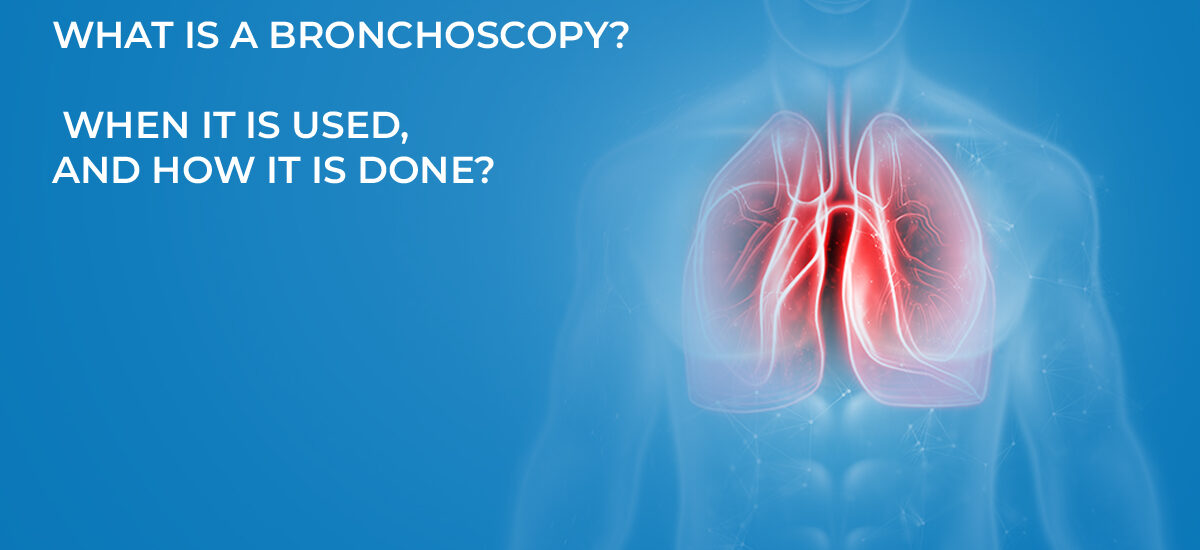What is Bronchoscopy?
Bronchoscopy is a medical procedure that involves the insertion of a bronchoscope, a thin and flexible tube with a light and camera on the end, into the airways through the nose or mouth. The procedure is used to diagnose and treat various conditions of the respiratory system, including infections, bronchitis, asthma, and lung cancer. During a bronchoscopy, the healthcare provider can look at the inside of the bronchi and take samples of mucus or tissue for laboratory testing. The procedure is generally safe and is usually done on an outpatient basis, meaning that the patient does not need to stay overnight in the hospital.
When is bronchoscopy used?
Bronchoscopy is a medical procedure that is used to diagnose and treat various conditions of the respiratory system. It is typically used to:
- Diagnose the cause of respiratory symptoms, such as coughing, wheezing, shortness of breath, and chest pain
- Identify the source of infections in the respiratory tract, such as pneumonia or bronchitis
- Obtain samples of mucus or tissue for laboratory testing to diagnose conditions such as lung cancer or asthma
- Remove foreign objects that may have been inhaled, such as a toy or food particle
- Treat certain respiratory conditions, such as bleeding in the airways or blockages caused by tumors or scar tissue
- Evaluate the effectiveness of previous treatments, such as bronchodilators for asthma or chemotherapy for lung cancer.
Bronchoscopy is generally considered safe and is usually well tolerated by patients. It is an important tool in the diagnosis and management of respiratory conditions and can provide valuable information to help guide treatment decisions.
Is bronchoscopy a major surgery?
No, bronchoscopy is generally not considered major surgery. It is a minimally invasive procedure that is usually done on an outpatient basis, meaning that the patient does not need to stay overnight in the hospital. The procedure is usually done with the patient under conscious sedation, which means they are awake but relaxed and do not feel any pain. The procedure usually takes about 30 minutes to an hour to complete. After the procedure, the patient may experience some mild discomfort, such as a sore throat or hoarseness, but these symptoms usually resolve within a few days. In rare cases, complications can occur, such as bleeding, infection, or a reaction to the sedative medication, but these are usually minor and can be easily treated.
How long are you in recovery after the bronchoscopy?
The recovery time after a bronchoscopy procedure depends on several factors, including the patient’s age and overall health, the reason for the procedure, and whether any additional procedures were performed during the bronchoscopy. In most cases, the patient can expect to spend 1-2 hours in the recovery area after the procedure, during which time the healthcare team will monitor their vital signs and ensure that they are stable. After the recovery period, the patient can go home, although they may need someone to drive them if they received conscious sedation during the procedure.
Most people feel tired for a few hours after the procedure and may have a sore throat or hoarseness. These symptoms usually resolve within a few days. The healthcare provider will provide instructions on how to care for the throat and when to resume normal activities. It is important to follow the instructions carefully to ensure a smooth recovery. In general, it is best to avoid strenuous activities for a few days after the procedure to allow the body to rest and heal.
Is bronchoscopy better than CT scan?
Both bronchoscopy and computed tomography (CT) scans are useful tools for diagnosing respiratory conditions, but they serve different purposes and have different benefits and limitations.
CT scans are a type of imaging test that uses X-rays to create detailed pictures of the inside of the body. They are often used to diagnose conditions such as lung cancer, pneumonia, and chronic obstructive pulmonary disease (COPD). CT scans are noninvasive, meaning they do not involve the insertion of any instruments into the body, and they can be done quickly, usually in less than 20 minutes.
Bronchoscopy, on the other hand, involves the insertion of a bronchoscope, a thin and flexible tube with a light and camera on the end, into the airways through the nose or mouth. During the procedure, the healthcare provider can look directly at the inside of the bronchi and take samples of mucus or tissue for laboratory testing. Bronchoscopy is usually done to diagnose and treat specific respiratory conditions, such as infections, bronchitis, asthma, and lung cancer. It is generally considered more accurate than a CT scan for diagnosing these conditions because it allows the healthcare provider to examine the tissue directly and obtain samples for testing.
In general, CT scans are better for imaging the lungs and identifying abnormalities, while bronchoscopy is better for diagnosing and treating specific respiratory conditions. The best imaging test for a particular patient will depend on their specific symptoms and medical history.





